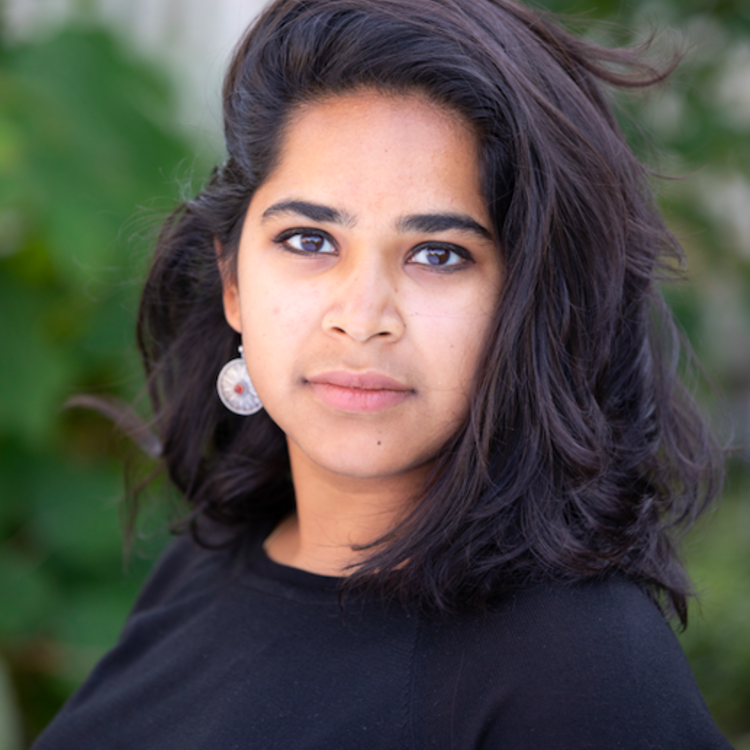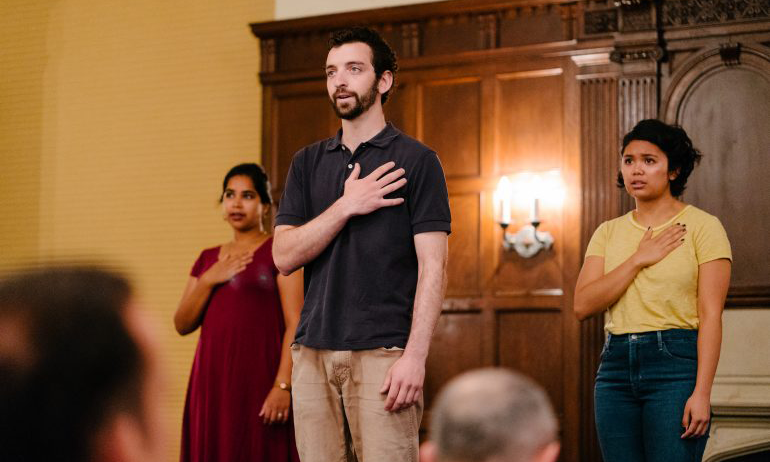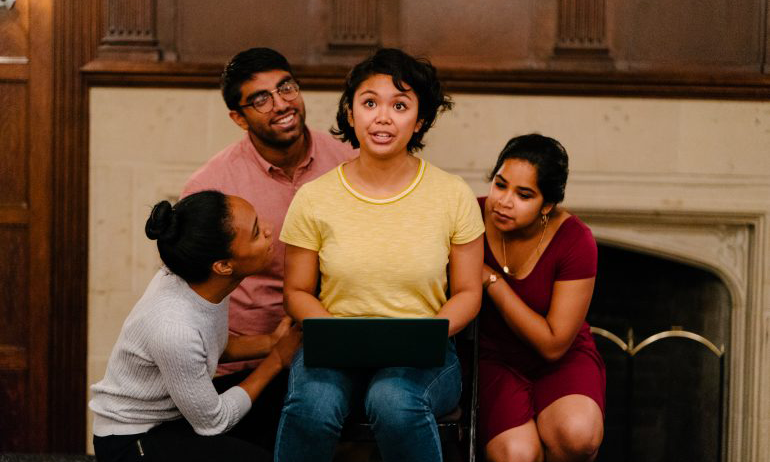This conversation made me curious about the ways in which migration can influence performance structures—in other words, I wanted to identify a migratory dramaturgy. I offer the idea that migratory dramaturgy is a constellation of various independent practices that encompass any sort of border crossing or transgression, including intersectional identities and struggles about the self.
Migratory dramaturgy involves movement of many kinds. Often, the performance is about physical movement, such as a population or an individual crossing a border; perhaps audience members also move through unfamiliar space. Migratory dramaturgy can also take the audience on an emotional journey towards new understanding or simply a short visit to a different perspective. The performance can transgress the borders of traditional venues, or it can move in its process, responding to political and social environments, changes in performers, or shifts in circumstances.
Despite the different practices in the constellation of migratory dramaturgy, what unites it is the intention of amplifying stories and voices in the struggle against a society that categorizes, ostracizes, and deports those who are deemed “unwanted.” From President Donald Trump’s campaign success on the promise to build a wall and travel bans against people from Muslim-majority countries, to literal and metaphorical fences erected throughout Europe, to the xenophobic sentiments in neofascist politics globally, migration has been center stage as far-right movements centralize political power. Migratory dramaturgy stands as a means of reclaiming narratives of migrants and emulating the resilience of these communities through performance.
Migratory dramaturgy interprets adaptation as a performer’s extraordinary awareness and responsiveness to the performance environment.
Adaptation
Theatre is accustomed to the concept of adapting a classic piece of art to make it more familiar, or more relevant, to a local audience. Similarly, as migrants adapt to their new environments, they blend customs and traditions to create new hybrid rituals. Borrowing from both of these notions, migratory dramaturgy interprets adaptation as a performer’s extraordinary awareness and responsiveness to the performance environment. The creators consider the audience, the political context, the community that the performance belongs to, and the aspect of immediacy. For example, freestyle rap draws inspiration from and makes commentary on the rapper’s immediate surroundings, interpreting and creating the space of the performance. Adaptive theatre with a migratory dramaturgy attempts to do this on a larger scale.
To demonstrate adaptation over time, I offer a project of my own called I Pledge Allegiance, which was developed as an interview-based exploration of American immigrant identity after President Trump’s election in 2016. The performance ended with a rewritten Pledge of Allegiance, which specifically included values that the Trump administration threatened to destroy. We pledged our allegiance to issues like undocumented family reunification, gun control, queer rights, and hybridized identities. These calls to action echoed the marches, protests, and rallies that marked the first six months of the Trump administration.
We first performed I Pledge Allegiance at the World Theatre Congress in Segovia, Spain, in front of a young international audience in July 2017. We learned that our play, which came from a specific United States context, could translate to other political environments—not because it claimed universality, but because the specific instances, images, and experiences were legible in others’ lives. People connected to the frustrations and hopes we expressed from their own political experiences with fascism and xenophobia around the world.
Over the following years of adapting and performing I Pledge Allegiance, we continued to update statistics, news stories referenced, and political flashpoints so that the play remained relevant, but we also reflected on the ways in which the political moment we were in was similar to those our ancestors faced when they arrived in the United States. We included our familial histories in the text and shifted the ending from echoes of protests to more personal pledges involving our hybrid immigrant-American family traditions. For instance, I pledged allegiance to food that comes from my mother's kitchen, the hum of Hindi music in our house all day, and slow mornings sipping chai from oversized mugs. While these pledges were less overtly political, they remained radical in their implications about survival, space, and cultural diversity within the United States. This shift was important to us—not in a disavowal of the pledges that had come before, but rather a reflection on the long-term resilience of immigrant communities in the United States who had fought for their rights.
Through adaptation in the most literal sense—making the Pledge of Allegiance fit our lives—as well as adapting the play over the course of several years’ reactions to administrative actions, we have had the opportunity to be continually critical and self-reflexive. In this way, adaptive theatre is a series of laboratories, which are all finished but never final.
When not listening is an act of power, radical listening—hearing and believing stories that are often ignored—is an act of subversion.
Retelling and Radical Listening
Traditions of oral storytelling are central to migration. As people move from one place to another, the act of retelling stories becomes more important as they try to preserve, remember, and recreate the concept of home. All the more importantly, stories of immigrants are often ignored by the media and the arts. When not listening is an act of power, radical listening—hearing and believing stories that are often ignored—is an act of subversion.
The practice of radical listening and retelling is exemplified in Chicago’s Albany Park Theater Project’s Port of Entry, which I saw as a work in progress in August 2019 before being hired as the company’s resident director. Port of Entry is an immersive experience that explores immigrant history in the city. In collaboration with Third Rail Projects, the play was created by youth artists who had grown up in Albany Park—many the children of immigrants themselves. The performance was an invitation into the homes of several immigrant families, leading audiences into intimate encounters with real stories.
Port of Entry consists of a number of retellings, most obvious being the stories of immigrant families collected by the young people. Like Albany Park Theater Project’s other work, the performance was devised from ethnographic interviews with community members, aiming to capture the experiences of the multicultural families that often share one apartment building in the diverse neighborhood. The interviews that inspired the piece were both recent—tales from current company members—and up to two decades old, given the company’s long and intimate history with Albany Park.
Albany Park Theater Project practiced radical listening in these interviews, trusting the stories—which ranged from quotidian to extraordinary—told to them by community members. They devised the play off of tales of violence, migration, family, and survival from immigrants from around the world. Some phrases from the interviews are repeated verbatim within the performances and others were reinterpreted as movement sequences, poetry, or atmospheric experiences. Producing artistic director David Feiner says the goal is to “honor the storytellers” and do justice to their oral histories, thereby creating a living memorial of the neighborhood.
The performance is also a retelling of stories that were familiar to me as an immigrant, even if they were not my own. Each scene brought me into the home of a different family and their culture, and while none of them were Indian-American, there were many aspects that reminded me of my own migration. For instance, a Burmese Keren refugee family’s arrival to their new home reminded me of my own family’s closeness during our many moves—a memory that stayed with me long after the staged moment.
Finally, the performance is a retelling each night. Albany Park Theater Project works with teenagers, and in order for them to respect the young people’s academic and family commitments, multiple casts switch between performances. The cast rotations harken back to the idea of adaptability, offer an opportunity for the stories to be retold as if they are new, and reinforce the collective ownership of the ensemble. On top of this, since the actors intimately interact with new audience members during each performance, they must listen and respond to the audience’s choices in the moment.
Retelling and radical listening are crucial to migratory dramaturgy’s building of community, both amongst the performers and the audience. Both notions invite the audience to witness stories that they normally do not, while honoring the storytellers with dignity and agency.
Retelling and radical listening are crucial to migratory dramaturgy’s building of community, both amongst the performers and the audience.
Invitation
The concept of migration, as we understand it in 2019, conjures images of refugees or economic migrants in search of opportunity and survival, often heading away from the Global South and towards Western nations. The migrant takes the role of a guest, beholden to the hospitality—or, often, lack of hospitality—of the “host” nation, its rules, and its citizenry.
Within migratory dramaturgy, I aim to flip the conventional host/guest paradigm by emphasizing the migrant as a host, a concept I adapt from LubDub Theatre Company in New York City. The act of hosting is central to immigrant culture. We bring visitors from our old homes into our new home, we forge traditions that bridge borders, we introduce ourselves to new neighbors by extending meals or sharing customs. Within migratory dramaturgy, the performers extend an invitation to the audience, leading them through an experience of immersion, site-specificity, or simply a set of new experiences and stories to which the audience may be unfamiliar. The aim of the invitation in migratory dramaturgy is not only to focus on underrepresented stories, but also to center the characters who are usually at the margins.
In July 2018, I saw The Jungle at the Playhouse Theatre, a mainstream and well-known space in London. The theatre had been gutted to create the world of the show in the Calais refugee camp: the seats were stripped, the floor was covered with dirt, a false ceiling was installed. Audience members sat on benches, cushions, and perches, all facing a runway stage—and each other. Despite the enormity of the theatre, this in-the-round seating arrangement allowed the audience members to connect to the performers as hosts and to each other as fellow guests. We were welcomed to the refugee camp—what Western media called “the Jungle”—with naan and chai before the performance, breaking bread with our hosts and each other.
The performance created an environment—both aesthetic and interpersonal—that was appropriate for the London audience. It addressed the middle-class and white demographic of the audience, often referencing white saviorism in the refugee camp. One of the characters was a white British woman who journeyed to Calais with intentions to “save”—but she was not, clearly, a host. The space was not hers. Instead, she and the audience were hosted by the residents of the Jungle: an Afghan café owner, a Syrian academic, and a Somali teenager. By flipping the usual host/guest paradigm, The Jungle exposed the weight of the asylum-seekers’ lives and the pressure of hosting. For instance, when the British woman breaks down after she hears of the Somali teenager’s traumatic past, the audience witnesses how she places more pressure on the teenager, who is then expected to comfort her. The questions of who we are hosted by, and how the world is translated (or not) for us, is crucial to the migratory dramaturgy that shapes this play.
Sometimes, when we host others, we water down our own identities in order to make the guest feel comfortable. I challenge migratory dramaturgy to host courageously, to tell stories that may be unfamiliar or challenging to audience members. Without encouraging Orientalism or self-effacing behavior, migratory dramaturgy must create an environment in which the audience is able to move—perhaps physically, but certainly emotionally.




Comments
The article is just the start of the conversation—we want to know what you think about this subject, too! HowlRound is a space for knowledge-sharing, and we welcome spirited, thoughtful, and on-topic dialogue. Find our full comments policy here